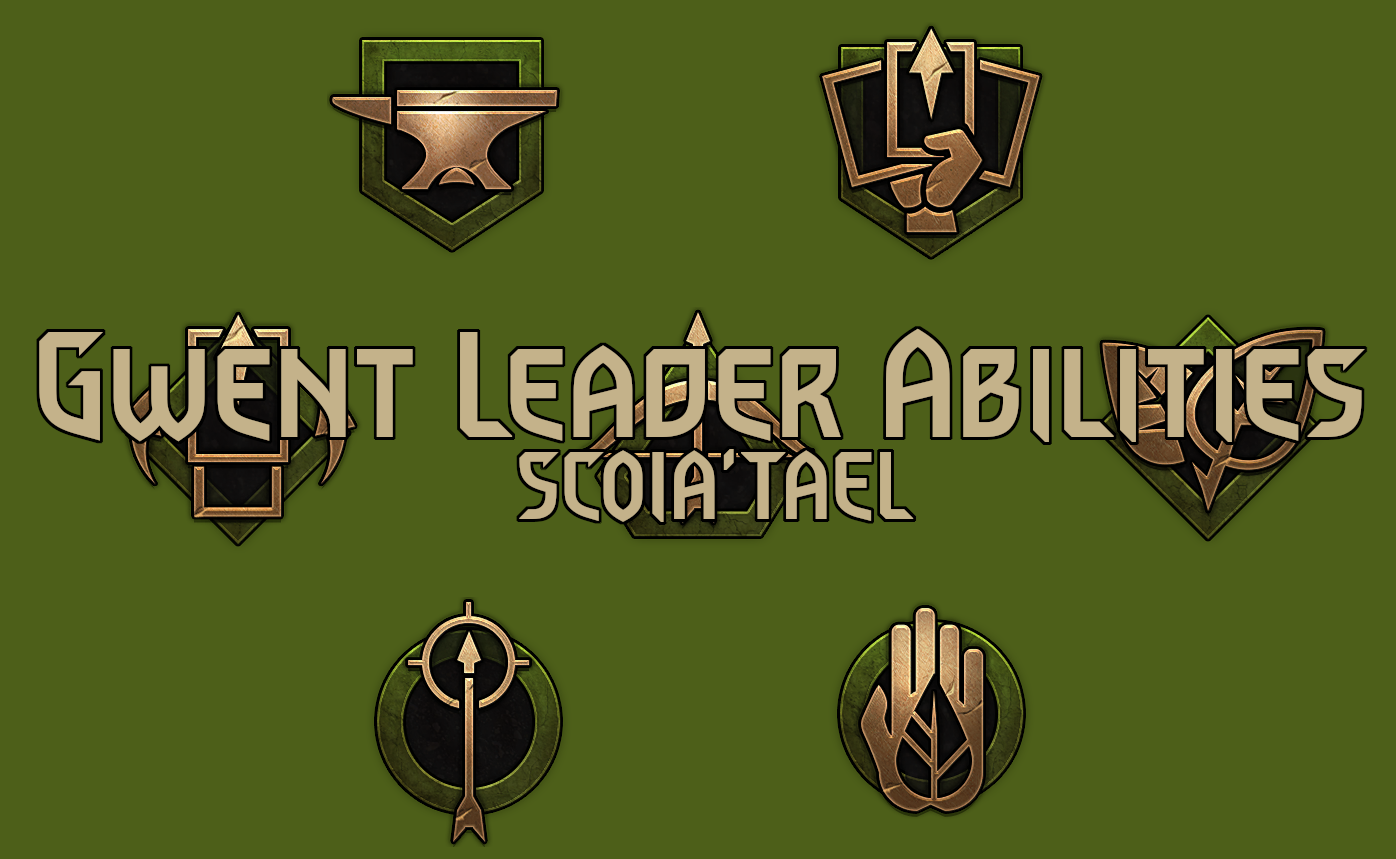Introduction
After General Guide To Leader Abilities In Gwent, we have moved into more detailed breakdown, faction-by-faction, following the alphabetical order:
- Monsters Leader Abilities In Gwent – Strategy & Decks
- Nilfgaard Leader Abilities In Gwent – Strategy & Decks
- Northern Realms Leader Abilities In Gwent – Strategy & Decks
This time we visit Scoia’tael. Each leader ability would be accompanied by a short characteristics, the most important synergies (importance rated with stars) and example decks.
All demo decks presented in the series could also be found in a Google Sheet.
Guerilla Tactics
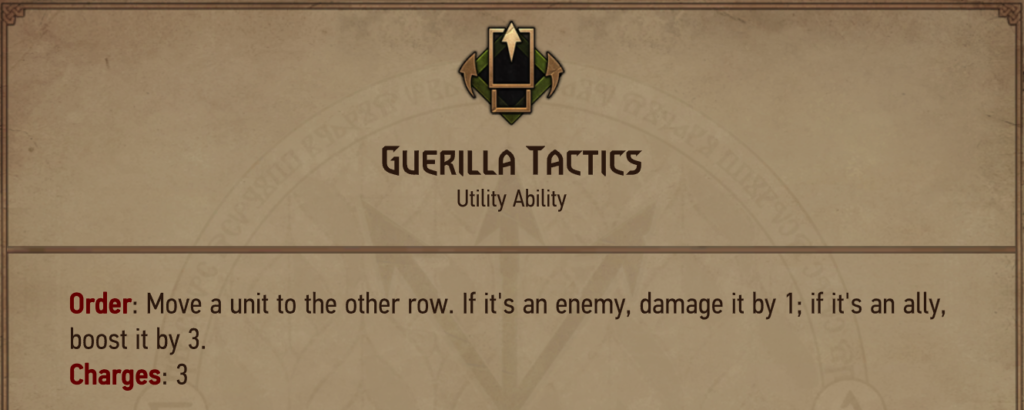
Guerilla Tactics is a mix of synergistic and pointslam leader ability (9 raw points when used defensively), which also has some control capabilities (offensive movement). Compared with pure pointslam leaders (Blood Scent, Tactical Decision…), the synergistic/control aspect of GT should bring at least ~5 extra points above the power vs provision curve. Guerilla Tactics is an ultimate leader ability, enabling rich interaction with the board and having many synergies with Scoia’tael cards.
- Movement Archetype *** | Guerilla Tactics defensive movement charges value could be increased when cards like Dol Blathanna Sentry or Milva are present on the board. Note that even with full leader use these cards do not play above power vs provision curve (DBS => 7 for 5, Milva 6 for 7 in Gwent 11.11). GT could support Movement Archetype, but value payoff is always slow and conditional; archetype has to work decently itself.
- Threat Protection *** | GT boost could bring a threat out of removal range. For example in Defensive Movement archetype GT may be used to protect engines rather than multiply value. While generally worse than Carapace (Monsters) in this application, GT has upside on row locked threats.
- Schirru *** | Schirru burns all the same power units. Thanks to Order+Zeal, GT defensive charges could be used to buff Schirru by 3 one or more times before burning. At the same time GT may bring own units out of Schirru range and opponent’s into it. Schirru is the strongest and highest ceiling standalone unit supported by Guerilla Tactics (Gwent 11.11).
- Milva: Sharpshooter *** | Milva: Sharpshooter in a sense enhances offensive capabilities of Guerilla Tactics, so that at ~7 excess provision cost (Gwent 11.11) we get a ‘new leader ability’. Now Guerilla could instant kill unit up to 3 power, all offensive movement cards potentially get +2 damage and at a chosen time, Milva is ‘spawned’ on the board, adding 4 points to leader and possibly setting up the board for cards like Schirru.
- Melee + Ranged ** | Weeping Willow and Forest Whisperer have order effects active in different rows than their deploy.
- Aglais * | Guerilla Tactics could directly +9 boost Aglais in one turn with all leader charges
- Incidental Control * | Guerilla Tactics just in case could counter opponent’s row locked units or move Defender protecting a threat.
- Row Punish * | Back in the days, Guerilla Tactics used to be the leader supporting Crushing Traps and other row punishes. But since offensive damage got nerfed to 1, this strategy is hardly viable. Also Milva:Sharpshooter is clearly anti-synergistic (deathblow) and couldn’t be used to support this approach.
- Vrihedd Brigade * | Vrihedd Brigade could turn 3 points Guerilla charges into 5 points. In Gwent 11.11 this card instant value is 6 points for 5 cost. With full leader we get 12 for 5; ~2 points above the curve. Not good enough to bring Guerilla Tactics amongst best pointslam leaders.
Demo decks:
- Guerilla Tactics Movement Nekker – GT is used as an engine protection or value on well developed board. For example moving Cat Witcher Mentor into other row followed by 4 frogs jumps is worth 5 extra points alone. Golden Nekker playing 3 cards in one turn helps to make slow, synergistic movement engines snowball faster together.
- Guerilla Tactics Milva Schirru – GT high-end use in this deck is preparing huge Schirru, but incidentally leader charges may be committed to remove threats with Milva:Sharpshooter support. Milva also gives more flexibility when setting up Schirru board on opponent’s side.
- Guerilla Tactics Harmony Schirru – Harmony here gets supported with Schirru powerplay and ‘Melee + Ranged’ synergy.
- Guerilla Tactics Drunken Aglais – an example of Aglais synergy deck; Locations are used to boost Aglais in the final turn. Boost value may be quadrupled thanks to Syanna.
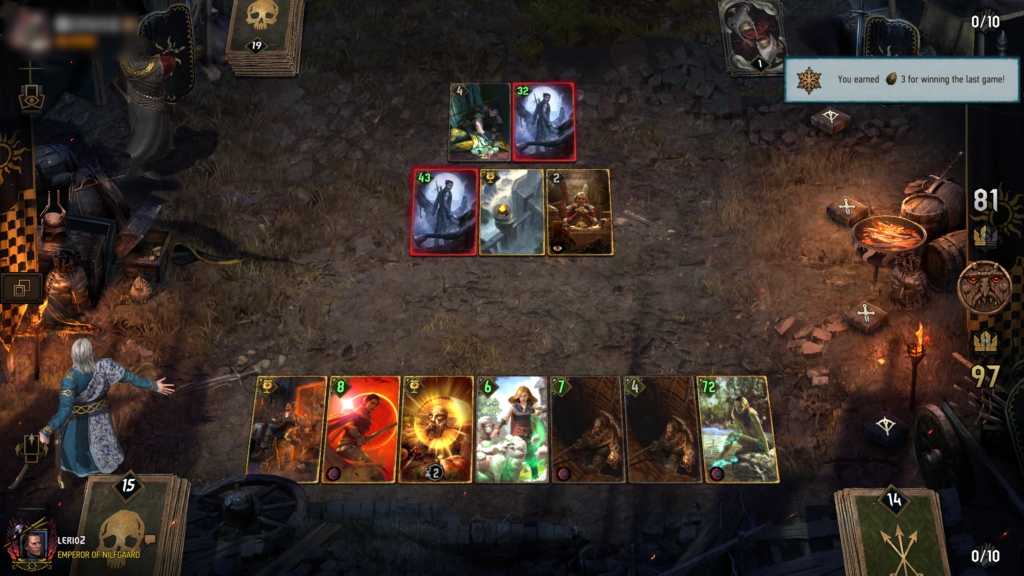
Invigorate
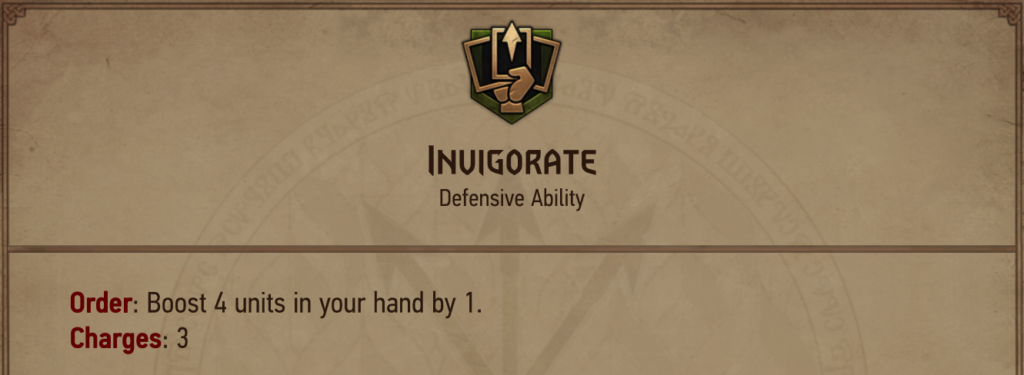
Invigorate is a pointslam leader ability worth 12 raw points.
- Farseer *** | If we look into cutting edge synergistic payoff cards for Invigorate, there is only one: Farseer. At small excess provision cost (2 in Gwent 11.11), it is possible to get up to +8 boost carryover for next rounds. Farseer boost power is equivalent to an extra bronze card. Compared with another Scoia’tael carryover card: Orb of Insight, we get +1 power and 4 more carryover, but less synergies (Gwent 11.11). The tradeoff is that Farseer decks high-end should be based on units and Farseer sequencing denies own control/engine play. Farseer may (but don’t have to) be combined with Torque, after which Torque instantly breaks even with respect to meta value.
- Engine Protection ** | Invigorate buffs do not protect one particular threat as well other abilities (Guerilla, Carapace, Shieldwall…), but when there are many of them, protection value could develop high value.
- Handbuff Payoff ** | Cards like Torque, Sheldon Skaggs or Watcher Of The Valley bring additional value when boosted before play. None of those cards is able to play on power vs provision curve alone with full leader ability; handbuff cards have to be run for them to return value.
- Round Control * | Invigorate (like Double Cross in Nilfgaard) may have troubles when defending a push. At 4 cards last leader charges have to be used if afraid of 2:0; then value is located on cards and the opponent would have leader advantage in R3. Round control is also very important when going into Handbuff archetype direction; then last say could protect points on units like Torque or Aglais.
In spite of the pointslam character, Invigorate is an interesting leader ability especially when it comes to game mechanics and defining winning strategy. With Farseer being the main payoff for running Invigorate, the deck has to be adapted to modified sequencing. Balancing between carryover and round control is another common motif: for example boosting Torque would scale 1:1 rather than 2:1 without last say vs tall punish in a typical handbuff. Yet with Farseer played early, contesting the round may become expensive and also not the whole hand could be played if carryover is meant to be kept.
Demo decks:
- Invigorate Renfri Handbuff – Renfri has good synergy with Invigorate, because 2x leader charges are already casually committed in Round 1 with Farseer. A good passive rolled from Renfri early could reach exceptional value.
- Invigorate Handbuff Nekker – Nekker has a small anti-synergy with Farseer, so that few Special/Artifact targets are run. Tutors are useful to find Farseers early. In this deck Sticky Situation is used to contest Round 1 or played purely for carryover with instant spring. Iorveth is used to reply Sticky Situation.
- Invigorate Riordain Constructs – Riordain is a strong tutor not only in Traps/Elves archetypes but also for example… Handbuff. Riordain helps to find Sticky Situation, Iorveth and Farseer early. Constructs package is run to balance pointslam with control – feel free to experiment with different packages.
- Invigorate Spella’tael Aglais – In this deck engine protection aspect of Invigorate is demonstrated; Syanna, Figgis, Sorceress and Whipserer are protected with leader. Instead of control, this build tries to outgreed opponent. Even if the opponent has a tall punish answer to Aglais it is possible to greed simple Seer + Ale infusions combo. Similar deck could also be built on Alzur.
- Invigorate Filavandrel Dwarves – Zoltan’s Company is one of more impactful and easy to set up special targets for Filavandrel.

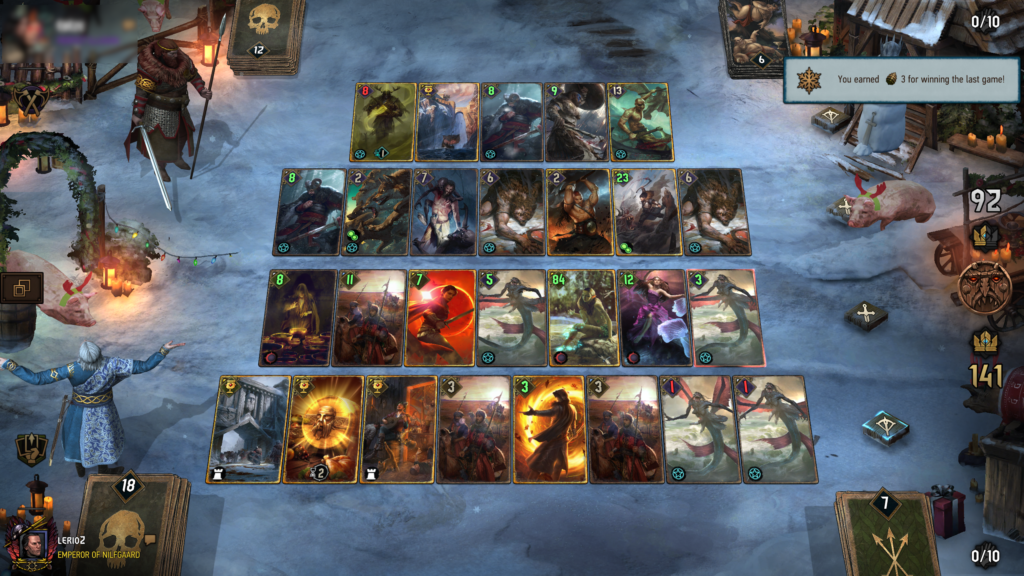
Nature's Gift
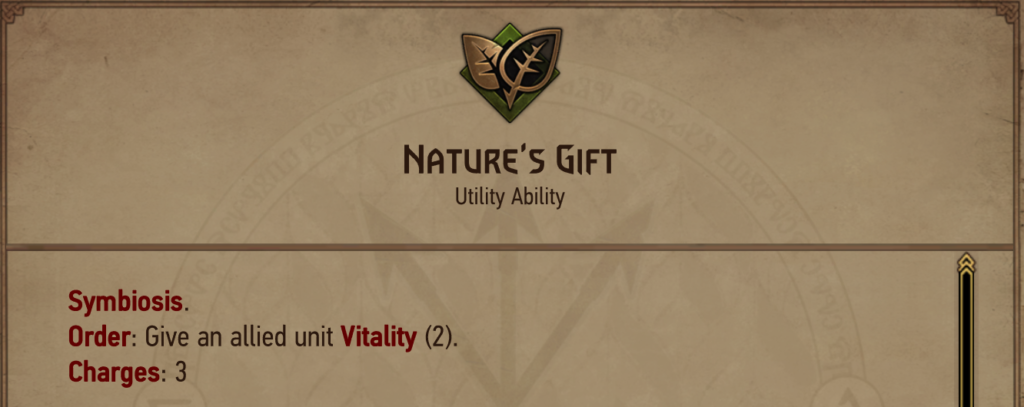
Nature’s Gift is a synergistic leader ability (6 raw points). The synergy is restricted to Natures cards payoff: spawning a wandering treant or boosting spawned treant by 1 (if Symbiosis is already present on board). Due to the pure pointslam character of the synergy, the passive part of leader ability must be worth at least ~9 points in practice to compete with meta decks.
- Nature *** | Nature’s Gift is fully coupled with Nature cards. The more such cards play on the power vs provision curve, the better Nature’s Gift is. At least ~9 of such cards must be played in the deck for the leader’s ability to be justified. Alternatively, strong Symbiosis cards may compensate for Nature cards lackings.
- Using Passive Points *** | Assuming that Nature’s Gift is additive to a meta level build which plays ~12 Nature cards, the raw leader ability power is 6 + 12 = 18. Way more points are located on Passive than on Active part of leader ability. At the same time, in a short round or even single long round 3, Gift effective value is not amazing. To make the most out of Gift value, passive points have to be transformed into permanent advantages. From the red coin (going second) the natural objective is winning on even cards. From blue coin, points need to be transformed into carryover or round control payoff. The latter could be long, first say push with Symbiosis engines.
- Vitality Payoff * | Hamadryads and Freixenet (in a devotion deck) get extra benefit from the impacted vitality.
Demo decks:
- Nature’s Gift Non-Devotion Symbiosis – Tempest and Spring Equinox are neutral nature cards which play on power vs provision curve in Gwent 11.11 and consequently non-Devotion Symbiosis is the main approach.
- Nature’s Gift Devotion Symbiosis – Compared with non-Devotion, the main difference is we get access to the powerful Symbiosis engine – Eithne: Wrath Of Brokilon. The Devotion Symbiosis is more complex strategically than non-devotion, because Eithne is very strong only in the last form, which makes the all-in Round 2 push less convenient.
Precision Strike
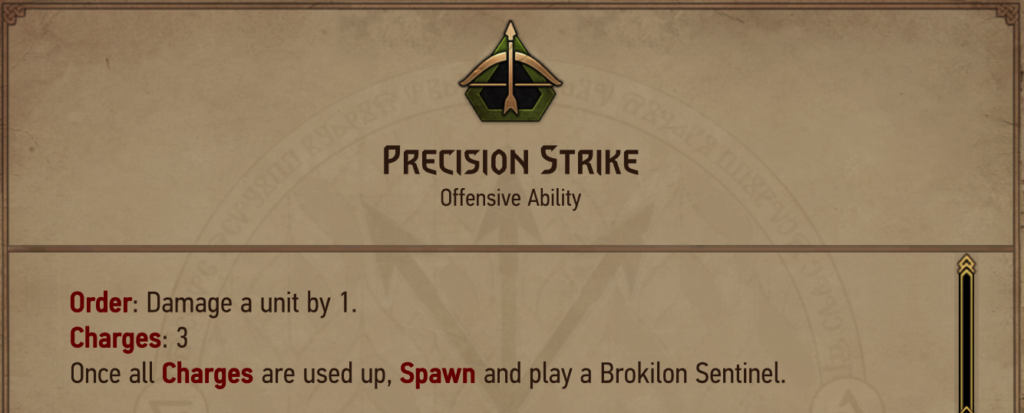
A pointslam + control leader ability (11 raw points with Brokilon Sentinels pair in the deck and deathblow).
- Damage Removal Support *** | Precision Strike pings support damage removal. For example if we have 4 damage reach on a card, and the opposing threat is 5 power, then one Precision Strike ping shuts it down. Efficient damage cards are better in PS than anywhere else. Most other leader abilities usually run straight removal, directly trading with the opponent’s threats. In PS damage cards support the leader and vice versa. It is advisable to run such cards in the high-end, not only amongst bronzes, because otherwise the synergy couldn’t be efficiently exploited in a long R3.
- Opponent’s Board Setup ** | Precision Strike could set up deathblow cards or whole board/row for cards like Schirru/Regis.
- Sentinel Thinning ** | Leader ability used early thins the deck by 2 if running Sentinels.
- Body ** | Precision Strike with Sentinels could provide extra body in a row, to be used with cards like The Great Oak or Commander’s Horn.
- Leader Carryover ** | With Allgod, Offerings and other deckbuff cards, Sentinels could accumulate carryover points coupled with the leader ability.
Precision Strike due to good pointslam and control value could support midrange, non-archetypical decks.
Demo Decks:
- Precision Strike Midrange Oak – Precision Strike supports Zoltan:Warrior damage and provides body for The Great Oak and Commander’s Horn.
- Precision Strike Dragons Renfri – Precision Strike here supports weak damage control, Saesenthessis: Blaze value and sometimes helps to thin better
- Precision Strike Simlas Waylays – Simlas + Waylays is a perfect high-end support for PS damage. In this list it is possible to get 5x Waylay with Feign Deth + Vanadain + Alissa. This type of list is more control focused and also often runs double tall punish. Demo version opts for the Hen Gaidth sword to highlight Deathblow setup.
- Precision Strike Dragons Hyperthin – demonstration of Precision Strike thinning – Saesenthessis: Blaze becomes a target for Yennefer: Divination and Triss Merigold. Then the dragon is retrieved with Myrgtabrakke. PS damage also supports the Bombs + Madoc package by improving removal and helps to build bigger Blaze.
- Precision Strike Frog Witchers – a demo of Precision Strike deckbuff carryover. Allgod and Offerings have multiple targets. Filavandrel should be boosted to 8 to guarantee Frog Mating Season and then tutored with Telianyn.
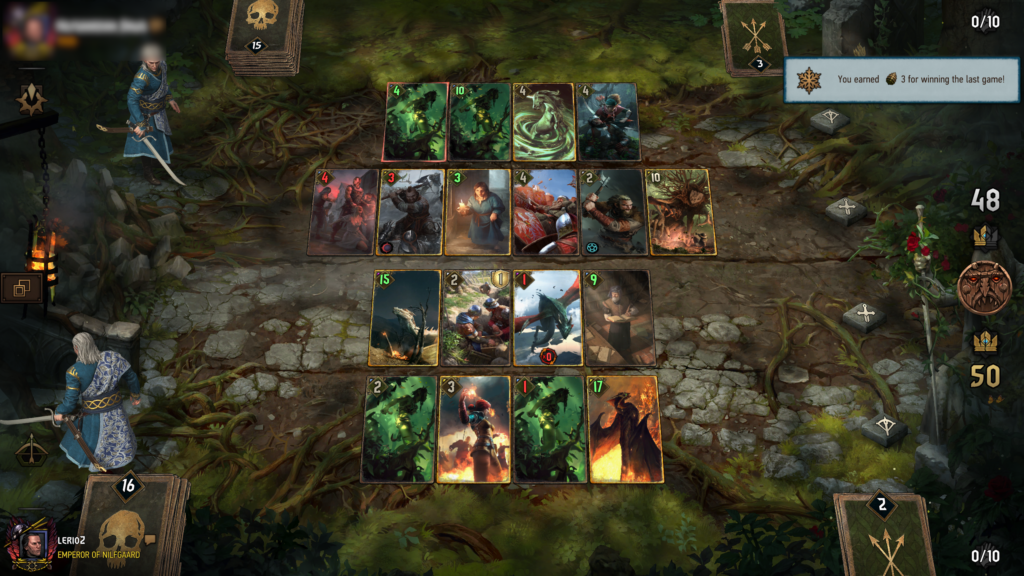
Deadeye Ambush
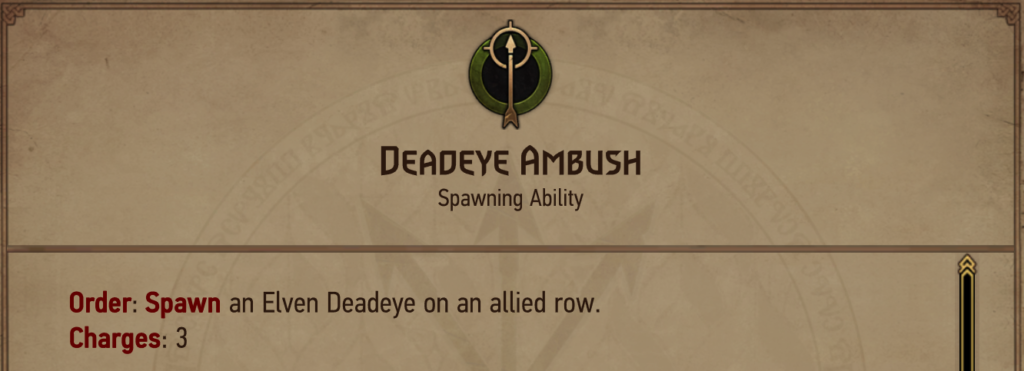
Deadeye Ambush is a mix of pointslam and synergistic leader ability (9 raw points).
- Elves *** | Elven Deadeyes spawned with the leader ability are support for Elves archetype payoff cards; for example +3 on Isenrgim Faolitiarna, +6 on Vernossiel played into melee row.
- Angus Carryover *** | Angus Bri Cri adds +1 to each leader charge power. Consequently Deadeye Ambush becomes stronger in a short round (12 raw points).
- Traps ** | By spawning units, Deadeye Ambush lets play Traps early without activating Spring.
- Body * | Elven Deadeyes provide body for row clog payoff cards.
While in the distant past Deadeye Ambush used to be run in midrange decks with Poison package, due to powercreep in Gwent 11.11 more points are needed, which makes DA decks similar to each other and tied to Elves payoff cards.
Demo Decks:
- Deadeye Ambush Heist Elves – Heist + Angus gives an opportunity of a win-con carryover play, where value is also maintained under leader ability. Deadeye Ambush not only synergizes for pure points with Elves payoff cards, but also catalyzes Vernossiel / Yaevinn removal plays.
- Deadeye Ambush Pure Elves – a mild, thematic version of Elves is also playable.
- Deadeye Ambush Traps Heist – Heist could be transformed with Eldain in a devo deck in case of not getting replay value. This version runs Vernossiel as a payoff card, pure traps version would include Isengrim instead.
Call Of Harmony
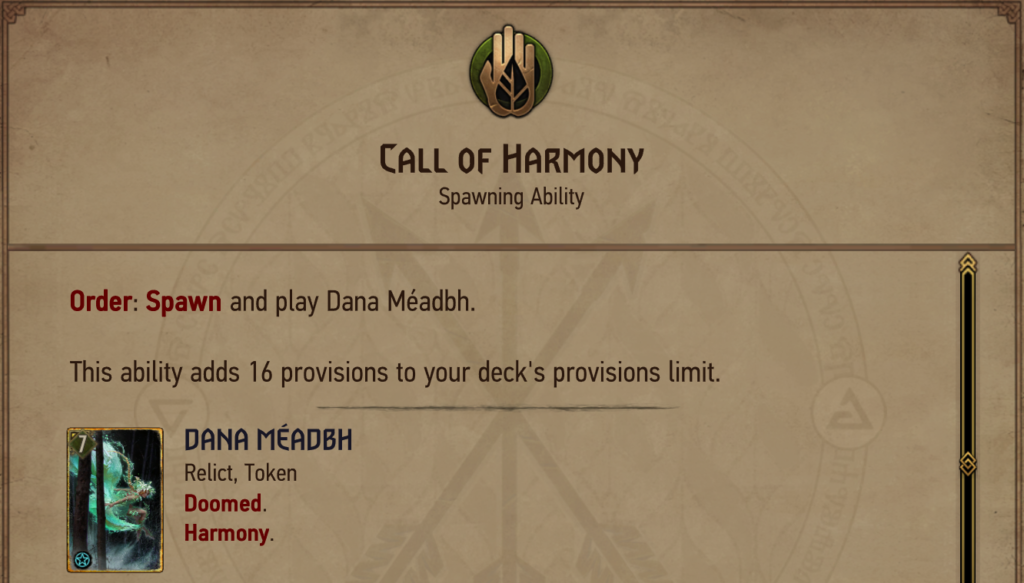
Call Of Harmony is a mix of pointslam and synergistic leader ability (~7 raw points). Dana Meadbh spawned by the leader ability benefits both from different non-neutral tags and overload of other engine threats. Dana scaling itself is slow; the longer the round is and the more tags are available, the bigger Dana grows, up to ~17p ceiling. Good value, but not outstanding if other synergies with leader ability are lacking.
- Harmony *** | Dana Meadbh is not only an engine, but an unique non-neutral tag to proc Harmony cards already present on the board. On a well-developed Harmony board if the Relict tag is missed, effective value could grow by ~+5 and Call Of Harmony overpoints best pointslam leaders.
- Quarixis *** | Playing Dana instantly triggers Quarixis, who otherwise would be low tempo and trade down to most control tools.
- Procing Dana *** | Dana requires various Scoia’tael unit categories in the deck in order to grow. That being said, without threat/ tall units overload, Dana would just grow up and play into tall punish. As a lonely pointslam, Call of Harmony is a very bad leader.
- Chameleon ** | Dana adds +3 to the effective Chameleon ceiling.
Due to synergies and limitations mentioned above, Call Of Harmony is a leader dedicated to Harmony archetype and unjustified outside.
Demo Decks:
- Call Of Harmony Ihuarraquax Quarixis – Call of Harmony in this list is coupled with Quarixis. Ihuarraquax activates Quarixis instantly when summoning, but could also be played into Dana in Round 1 to pull out the opponent’s win condition and threat a huge carryover.
- Call Of Harmony Waters Pavko – Water of Brokilon perfectly fits Call of Harmony, which develops +2 value from this card. In this wholesome (but still playable) version Saska:Commander got cut in order to run the cutest units in the game: Pavko Gale and Oakcritters.
Mahakam Forge
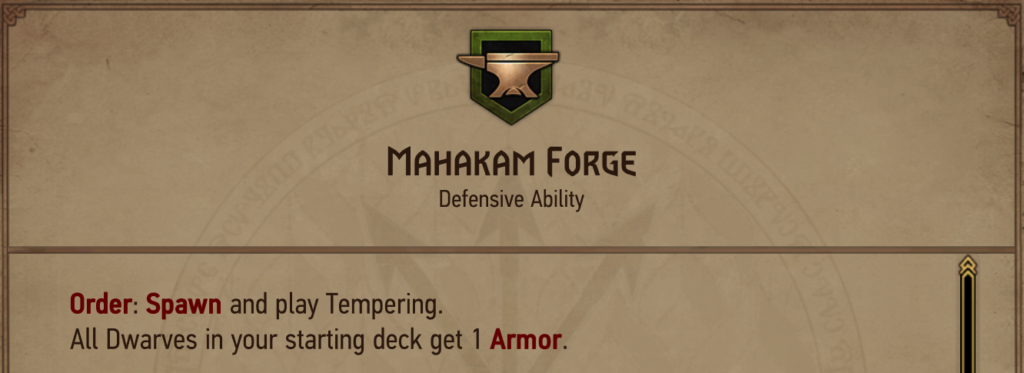
Mahakam Forge is a highly synergistic leader ability (only 5 raw points).
- Dwarves Armor *** | Mahakam Forge adds +1 armor to every Dwarf card present in the deck. This armor could be transformed into value in casual ways – protecting threats or sinking damage, but also with Armor payoff cards characteristic for Dwarves archetype. Zoltan:Warrior, Mahakam Marauder and other dwarfs with Barricade effect but no armor are instantly activated. Dennis Cranmer or Marauders get +2/+1 if targets had +1 armor thanks to Mahakam Forge.
- Mahakam Marauder *** | Due to Barricade effect on deploy, Mahakam Marauder couldn’t be activated on board with a card like Dwarven Chariot. Armoring a unit in hand is complicated, therefore stable Marauders are the main upside with respect to other leaders running Dwarf package.
- Reenabling Barricade ** | Tempering could reenable important Barricade effects on Dwarf cards, most importantly Brouver Hoog.
- Tempering Armor Value ** | Outside Reenabling Barricade, +2 armor from Tempering may be converted to points with cards like Mahakam Marauder, Dennis Cranmer, Iris:Shade or Yarpen Zigrin. Still may be inconvenient because of going tall; heavily armored unit is a good removal target when boosted further with Tempering.
- Tempering As A Special * | Mahakam Forge plays Tempering, which is a special card and has some synergies with Special payoff cards like Harald Gord, Prism Pendant or Whisperer of Dol Blathanna.
The active part of Mahakam Forge – spawn and play Tempering – is relatively weak. With one 1:1 Armor payoff card it is worth 7 points – two times less than best pointslam leaders in raw points. Even when elements of Dwarves archetype are on meta level, often a different leader ability is chosen to accompany them (Precision Strike, Guerilla Tactics in Gwent 11.11). The only exception is when Mahakam Marauders could reach high value in the meta.
Demo decks:
- Mahakam Forge Constructs Living Armor – Living Armor supports Constructs package, but also has great synergy with Mahakam Marauder and may be armored for pure value with Dwarven Chariot. Tempering would usually be played on one of cards to be buffed with Dennis Cranmer or to protect Colossal Ifrit.
- Mahakam Forge Brouver Dwarves – Here Tempering would usually get value by reenabling / protecting Brouver Hoog / Zoltan:Warrior.
- Mahakam Forge Pendant Nekker – Tempering combined with Prism Pendant brings extra +4 vitality. It could also be used to launch a chain of specials with Orb of Insight in the graveyard in the same turn a unit is played (same effect could be achieved with tutors).
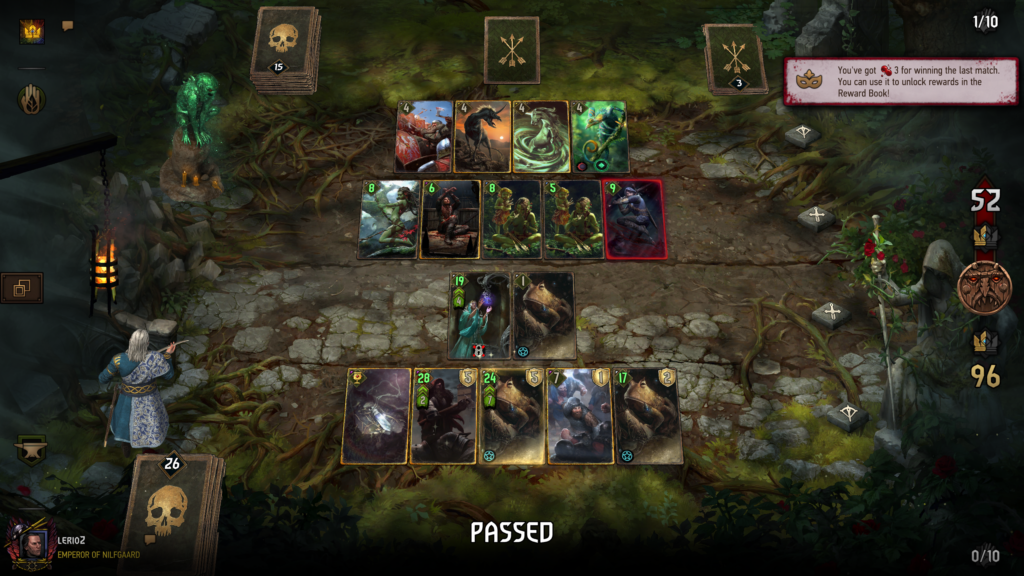
Summary
- While Monsters leader abilities were mainly characterized by good pointslam and internal synergies, Nilfgaard had significant fraction of control leaders and Northern Realms were tied to cards, Scoia’tael is varied. Precision Strike, Guerilla Tactics and Invigorate could support different decks, while Mahakam Forge, Deadeye Ambush and especially Call of Harmony & Nature’s Gift are tied to one or two archetypes.
- Precision Strike and Guerilla Tactics could impactfully interact with the board, while the rest of leader abilities is rather solitaire.
Closure
Hope you enjoyed this overview of Scoia’tael leader abilities and maybe would like to try some of presented decks/ideas yourself. Feedback is very welcomed; if you know about other decks/ideas making use of ST leader abilities, please let me know – I may update this article accordingly. Also if you tried any of demo lists from this or preceeding articles, feel free to share your thoughts and maybe spicy pics. Next faction in order: Skellige.
All decks from the series could also be found in a Google Sheet.

